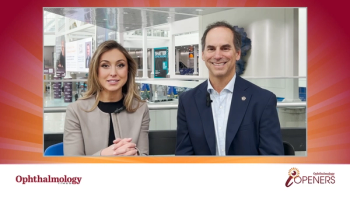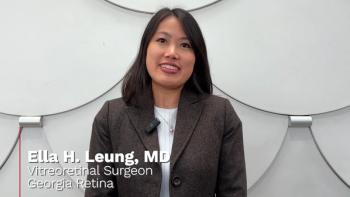
- Ophthalmology Times: November 15, 2020
- Volume 45
- Issue 19
Ophthalmic practices eye private equity investors
Business strategy can prove beneficial for physicians at any stage of career.
Bringing private equity investors into the health-care space can be an ideal decision for some practices, according to Steven I. Rosenfeld, MD, FACS.
But how should physicians determine whether their practice needs such ownership?
For practices looking to grow, private equity investors (PEIs) offer a way to grow organically—expanding an existing practice by bringing on more physicians and offering more services—as well as externally, via acquiring other practices or ambulatory surgery centers (ASCs). Purchasing or building new offices/ASCs can also be a strong indicator for reverting to private equity.
Doctors interested in limiting their personal liability may also turn to PEIs, according to Rosenfeld, a voluntary professor of ophthalmology at the Bascom Palmer Eye Institute at the University of Miami School of Medicine, where he previously held a full-time position, and president of Delray Eye Associates, PA.
To build and/or purchase new offices or ASCs, doctors usually have to sign on the dotted line. “Now if you have a private equity investor, it is somebody else’s name on the documents,” said Rosenfeld, explaining that ownership provides funding instead of loans with personal guarantees.
Although private equity (PE) can also give senior physicians an exit strategy, it is more than that, according to Rosenfeld.
“Private equity is not looking to buy a practice if they think all the doctors age 50 or older are going to be out the door in just a few short years,” he said. “That is not a good model.”
Patients are coming in for their doctors and their respective practices. A practice does not have the same value if, within a few years after a private equity purchase, everybody leaves, Rosenfeld said.
Related:
What PE offers
PE partners’ business acumen may also improve the profitability of a practice. Not all doctors are good business people, Rosenfeld said. A business partner can come in handy to help think decisions through; PEI can also lower a practice’s overhead.
When a practice is purchased by a PEI, its employees become the employees of that company. As a result, those employees receive their workers’ compensation, health care, and disability insurance through the partner.
PE also provides corporate funding for practice growth—an advantage for those interested in purchasing or building other practices and offices—and outsourcing for corporate needs.
Such needs include recruiting office personnel, administrators, and new physicians as well as providing billing, human resources, and compliance.
Additional benefits of PEIs may include marketing skills and advanced analytics for measuring a practice’s performance.
Related:
What makes a practice appealing to PEIs?
Growing, insulated income stream
Practices have a constant and growing income stream over time.
“Relatively speaking, we are insulated from what goes on in the market,” Feldman said.
As a practicing physician in South Florida, Feldman said the market is heavily Medicare based. If the stock market were to tank, ophthalmologists would continue to receive the same fee for service. “We have what is called a ‘low beta,’ so we are very dissociative from what happens in the stock market,” he said.
Succession plan in place
Feldman’s practice was equipped with solid succession planning when purchased by a PEI. “We had doctors shortly out of training on up to those who were closer to retirement or more senior,” he said.
Noncovered medical/surgical procedures
Noncovered medical and surgical procedures, such as premium lens implants in cataract surgery, femtosecond laser surgery, or cosmetic surgery—often called patient-shared billing responsibilities—offer opportunities for practices to become more insulated from what occurs with Medicare reimbursement. A doctor may even have the option to raise the rates for these noncovered services, Rosenfeld said.
Loyal patient base
A long-standing loyal patient base can also be of value: If doctors leave, patients leave. “Patients aren’t coming because they like the practice; they’re coming because they like any 1 of the 9 individual doctors that work in our practice,” Rosenfeld said.
Related:
Hub-and-Spoke model
A larger practice with multiple subspecialties under one roof can implement a hub-and-spoke model.
This involves establishing a “hub” that receives the heaviest resource investments and supplies the most intensive medical services, complemented by satellite campuses or “spokes,” which offer more limited-service arrays at other sites in any specific market.1
“If we can acquire 1, 2 or 3-person practices that do comprehensive ophthalmology … then we become the logical source for their retinal referrals, corneal referrals, glaucoma referrals, etc,” Rosenfeld said.
Geographic location
A PEI purchasing multiple locations across the area is often a buying point for the PEI and a selling point for practices. Rosenfeld’s practice was attracted to its respective PEI in part due to the 6 practices the company had already bought in South Florida.
Enhancements
The intent of PE ownership is not only to increase the profitably of a practice but also the productivity of its doctors. This comes with increased patient volume, particularly if a practice is part of a larger platform of services.
“If you have ancillary personnel to handle some of the more routine things, then the doctors have more time to handle the more costly, tertiary medical care or surgical procedures,” Rosenfeld said.
If part of a larger platform, a practice can gain leverage with commercial payers in the area and buying consortiums for some of the larger medical equipment or supply companies.
Related:
A PEI also will often assume administrative hassles—increasingly numerous and burdensome—as well as provide financing for future technology costs and purchases needed by a practice.
Private practice downsides
As with any form of ownership—PE included—the current private practice model features advantages and disadvantages for both sides.
Younger ophthalmologists often have different priorities and sense of work-life balance, according to Rosenfeld.
“They don’t want to be bothered with the administrative hassles of running a practice; they don’t want to buy into a practice,” he said.
In a traditional private practice setting, an ophthalmologist would come into a practice after a certain number of years as an associate and then become partner and buy into the practice. When retiring, the doctor would get bought out.
In today’s practice model, Rosenfeld has observed that younger doctors coming out of training are often choosing to remain employees in lieu of buying into a practice. He noted that this decision is not dissimilar to being part of a practice owned by a PE group, with the option to buy equity over time.
Related:
“In some respects, some of our younger partners felt that the private practice model was possibly not sustainable in the long run,” Rosenfeld said, “because if you have to keep buying out retiring partners behind our existing young partners to buy them out, they’d be stuck holding an asset that they couldn’t sell to anyone or couldn’t easily sell.”
PE benefits
For senior ophthalmologists in a practice, PE ownership could be an exit strategy.
Although some physicians may look to sell their practice and leave shortly after, that can affect its value, Rosenfeld said. As a result, it is not uncommon for PE companies to expect a minimum 3- to 5-year employment agreement following the purchase of a practice.
Doctor-patient relationships are of great value as part of a lucrative buyout, according to Rosenfeld.
“What a partner will get for selling a practice to private equity will be a larger buyout than they would get if they just executed the normal private practice documents at the end of their regular work time,” he said.
Continued growth of a practice without any personal guarantees is also permitted through a PE acquisition. If a practice partner chooses to continue working in the field following a purchase—and wants to buy or build another practice/surgery center—older doctors may become risk adverse and not want to put their money into long-term investments, according to Rosenfeld.
Related:
“And now, again, it is not a matter of the doctors signing for it as your private equity investor,” he said.
With PE, those partners are given the option to invest in the new platform.
Junior partners
PE also allow for younger partners to have access to continued growth beyond a practice without the constraints of a risk-adverse or less-entrepreneurial senior partner.
“Younger partners sometimes tend to be much more entrepreneurial, and they see the need for social media,” Rosenfeld said. “Things that sometimes older doctors do not. And there can be a bit of dichotomy.”
In Rosenfeld’s practice, the junior partners were able to take some money off the table to use to their advantage.
“They felt that—in 5 years, 10 years, 15 years—medicine will not be the same, our practice would not be worth the same, and that this was some kind of window of opportunity,” he said, explaining that the junior partners chose to accept a nest egg—with a sum far larger than they would have received if they had decided to retire under normal circumstances—and invest/leave it untouched until retirement.
Often in a PE buyout, the company may want doctors to roll over some of the purchase price into the new business—often called the “second bite of the apple.”
From a PE perspective, it is good business sense, Rosenfeld said. The situation is similar to a doctor having his own partners buy into the traditional model.
Related:
“The doctors now have some skin in the game, and that makes perfect sense,” he said.
But if the time comes for a practice to be sold to another corporate partner or company, then the doctors who invested will receive their money back, typically in a multiple.
This can often be very lucrative, according to Rosenfeld. The money being rolled over is not lost. If investors are fortunate enough that the platform or practice is sold again, it can be a windfall for all, he said.
Misconceptions
Physicians may assume PE partners will take total control and micromanage a practice upon acquisition. In Rosenfeld’s experience, that is not the case.
“They have evaluated your practice closely, they have looked at your quality of earnings, they’re buying your income stream, your EBITDA [earnings before interest, taxes, depreciation, and amortization], and they don’t want to disrupt that,” he said.
Partners buying a practice generally intend to keep operations as is.
“A private equity partner wants to work with you and refine what you do—not make postsale changes,” Rosenfeld said. “They understand the skills and the relationships that you have.”
Concern over focusing on just the bottom line instead of the quality of a practice is another misnomer. PE understands quality and the need for quality medicine to have a good business and to maintain relationships with patients and doctors in the area, according to Rosenfeld.
“They’re not looking to disrupt that,” he said.
Related:
Why partner?
According to Rosenfeld, his practice chose to partner with its PEI for the following reasons:
- Received a fair evaluation on the practice
- Shared same philosophy and values
- Shared similar vision for future growth
- National platform-level attractive for regional consolidation
- Negotiated certain guarantees
- Insured by Ophthalmic Mutual Insurance Company
- Employment/benefits for employees guaranteed for 1 year
- Found financially strong partner with funds to support practice growth
- Found partner experienced in health care and ophthalmology fields
- Was able to hire investment banker and corporate attorneys with PE experience to assist
Other key factors included a “pari passu” agreement, in which the shares of the practice’s doctors in the new platform are treated equally with the partner’s shares, according to Rosenfeld.
“So if the private equity partner leaves, we can get bought out,” he said. “And we get bought out in the same multiple, the same price.”
The agreed-upon exit strategy following the sale and employment-agreement expirations was also determined to be fair, along with providing an opportunity for future doctors to invest in the new platform.
Related:
A final selling point was the window of opportunity available for the practice.
There is often a period of 18 to 24 months in PE when the purchase price becomes higher until it hits a plateau and begins to descend, according to Rosenfeld.
“The more consolidation in the market, the less value any given practice has,” Rosenfeld said. “So we thought it was the right time.”
--
Steven I. Rosenfeld, MD, FACS
p: 561/498-8100
Rosenfeld has no financial disclosures related to this content.
---
Reference
1. Elrod JK, Fortenberry Jr JL. The hub-and-spoke organization design revisited: a lifeline for rural hospitals. BMC Health Serv Res. 2017;17(suppl 4):795. doi:10.1186/s12913-017-2755-5
Articles in this issue
almost 5 years ago
Evaluating scleral biomechanics to pinpoint root of accommodationabout 5 years ago
FA implant outperforms anti-VEGF in DR patients lost to follow-upabout 5 years ago
Challenges to topical drop adherence after cataract surgeryabout 5 years ago
Gene therapy surgical pearls for successful outcomesabout 5 years ago
Eliminating preop fasting leads to happier cataract patientsabout 5 years ago
Pearls for drawing patients back to your practiceabout 5 years ago
Haptic flanging reduces IOL dislocations after cataract surgeryabout 5 years ago
AMA steps up support for gender equity in medicineabout 5 years ago
Oh, the people we meetabout 5 years ago
Neuro-ophthalmology, NFL connect for a touchdownNewsletter
Don’t miss out—get Ophthalmology Times updates on the latest clinical advancements and expert interviews, straight to your inbox.













































